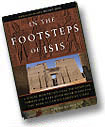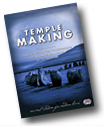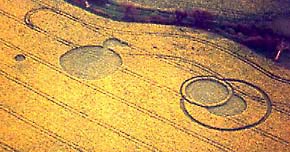 |
||||||
|
Geometric analysis of 1998s first pattern reveals a wealth of information. Text, diagrams © Freddy Silva. Photo ©Ute Sayer
In February 1998, seven popped into my head. I had no idea at the time what this was supposed to mean. Would there be only seven designs that year, would heptagonal geometry finally prevail in the fields? Three months later, the first salvo of the season appeared as a pair of formations at Weyhill- the first was a set of ragged thought-bubbles at one end of the field which didn't do anything for me, to be honest; the second, a pattern consisting of a circle overlapped by a ring, looked promising. In the previous year, the first two season openers at Barbury Castle and Stretall gave us the hexagonal code that was the framework for the most important designs of 1997. And so I began dissecting the aerial geometry to see if indeed there was merit to this idea.
The Weyhill design yielded quite a number of surprises. In fig. 1 we see how the unmistakable patterns of Gerald Hawkins' Euclidean-based crop circle Theorems II and IV are encoded. Theorem III- the square ratio- is also present, although it is technically not applicable by Gerald's rules because its outer ring is not rooted in the physical design; I include it because it is generated by extending the bisection of Theorem II (the triangle) and using the contact points with the formation's outer ring. The reason for this will be apparent in a moment.
In fig. 2 the first 'code' is shown as a pentagram encompassing the entire physical design. You can begin to appreciate how the geometries begin to interrelate at the various contact points (marked by dots). Later in August one of the season's most powerful crop circles made use of pentagonal design at Beckhampton (a second appeared at Avebury Trusloe, a third at Silverstone).
With seven still shouting in my ear, I applied heptagonal geometry to the Weyhill design simply by following the contact points already established by the three Theorems. The result is fig. 3. By further connecting the outer points of the heptagon's star, other connections can be made to the physical design, but they will be too confusing to be shown here as a diagram, so I'll leave you to play with that one. Again, 1998 later offered the first crop circle designs blatant based on the seven-pointed heptagon- Stockbridge, East Field and Tawsmead Copse (see History of 1998). But assuming my analysis is correct, it may prove that season openers do give us a taste of what is to come.
There is one last facet about Weyhill 98 that may be of interest. I began to detect an unusual design overlaying the entire geometric framework, like a hologram. In fig. 4 you will notice how two angles, 60ª and 45º, are created from the framework. These reveal the symbol that is synonymous with Freemasonry- the compass over the carpenter's rule, which together also symbolize our inseparable divine (spirit) and human natures- which esoterically are both symbolized by the aforementioned heptagon and pentagram. Now, I'm not personally fond of looking for things to drop a theory into but I find this a remarkable coincidence, more so when you consider that 98's first major pattern- the Beltane Wheel opposite Silbury Hill- was garnished with a ring containing 33 'S'. 33 is not a number one chooses by accident. It is the age of the crucified Christ, the number of vertebrae in the human spine, and the highest degree in Freemasonry. This idea, therefore, may not be so far-fetched. This work is an extract from Freddy Silva's book, Secrets In The Fields. © Freddy Silva 1998 |
|||||||||||||
|
Return to Case Histories
|
|||||||||||||
 |
 |
 |
 |
||||||||||
 |
|||||||||||||
 |
|||||||




